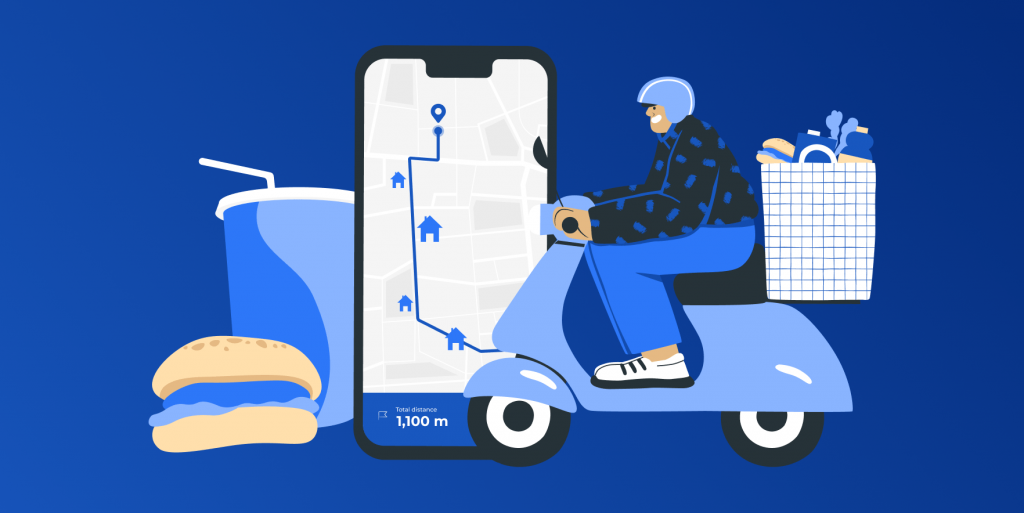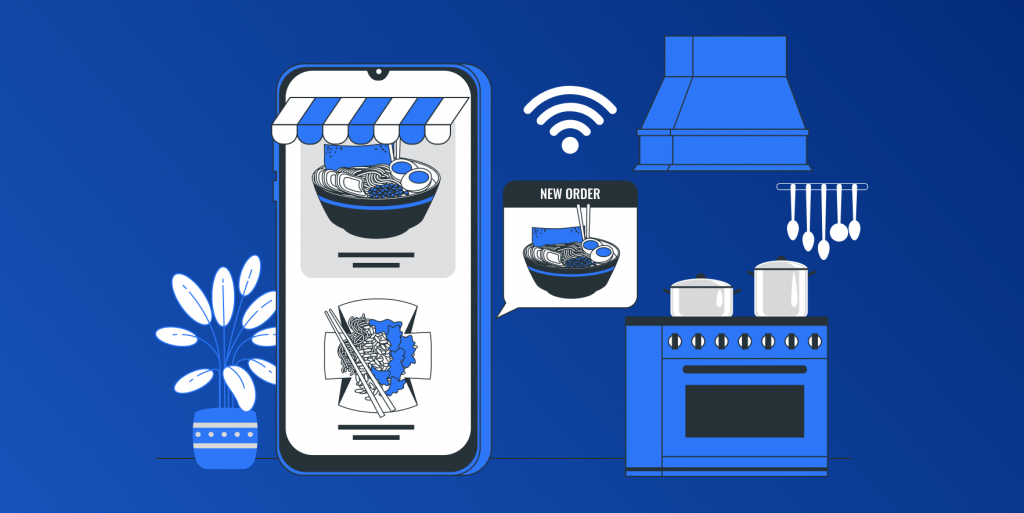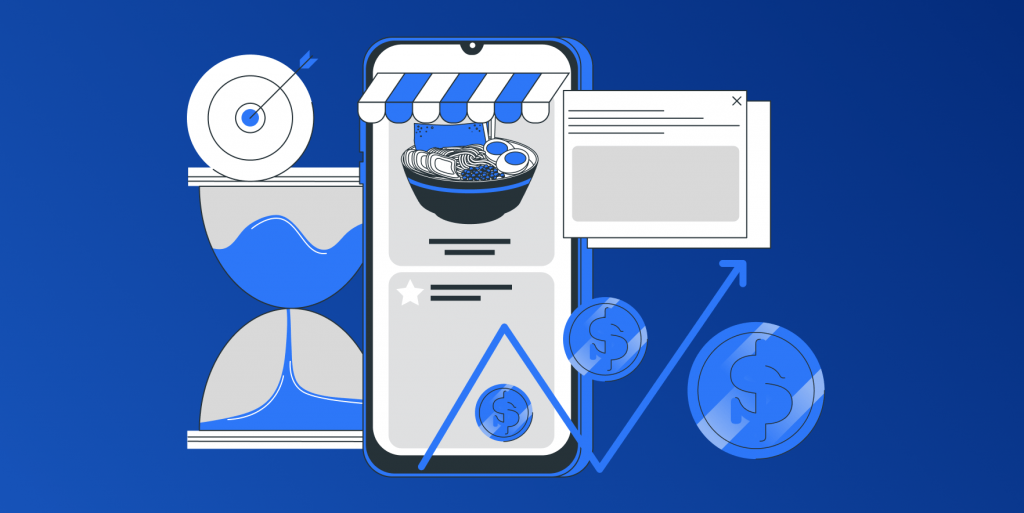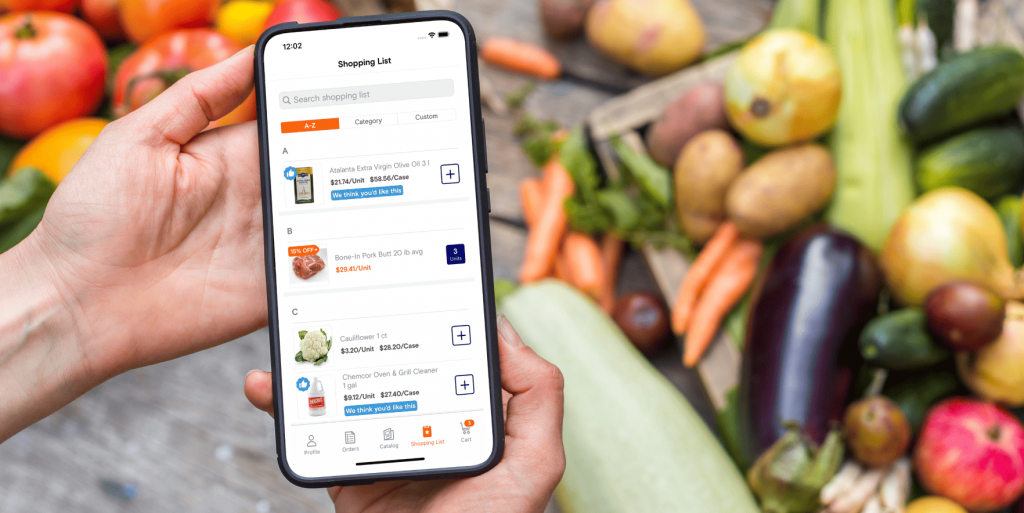Table of Contents
Food delivery has always been popular but after the pandemic, it skyrocketed in popularity. And, despite the presence of such huge players as Uber Eats, Grubhub or DoorDash in the market, it is surprisingly not oversaturated. That means the food delivery app development is a profitable venture – but you need to know the basics and prepare a solid business strategy in advance.
Below we talk about the essentials of creating a successful food delivery application and discuss available types and approximate costs. We hope our article will give you a good idea about what a food delivery app should look like and what business model will work best for you.

The state of food delivery app development today
The popularity of food delivery apps is growing consistently and it includes both grocery delivery and meal delivery. Statista shares the following numbers:
- The grocery delivery market volume is expected to reach $US$0.77tn in 2024;
- There will be approximately 2.5bn users in the meal delivery market by 2029;
- The online food delivery market is expected to display a 2024 – 2029 CAGR of 9.04%
As you can see, the statistics clearly show that the food delivery market displays consistent growth and is here to stay. And as we mentioned earlier, despite a big number of available solutions, the market still gladly welcomes new players, meaning you have all the chances to become the next big thing in online food delivery.
Why is food delivery so popular and beneficial for investors?
Now, the first thing that comes to mind is convenience since it’s extremely convenient to have your favorite food (or groceries) delivered right to your door within half an hour or so. But what’s in it for developers and investors and what factors make food delivery so profitable?
Rising demand for delivery services. The pandemic was probably a breaking point for the food delivery industry and today, it’s hard to imagine one’s week without at least one delivery order. What that means is that the demand for such services is still on the rise and with the right business model and reasonable fees, it’s possible to measure up to the biggest players in the market.
Beneficial for both restaurants and customers. Convenience and ease of online ordering are the key factors encouraging customers to participate in it. In fact, customers may be even willing to pay extra fees just for the sake of the convenience. As for the restaurant owners, the growing number of customers equals growing profit, so it’s a win-win for both parties.
Opportunities for personalization and automation. Online ordering (whether of meals or groceries) is a much faster and more personalized process than on-premises one. Businesses can offer their online customers such perks as gift cards, loyalty points, or discounts on special occasions. While some of these perks are applicable for on-premises ordering too, the online process just takes less time and effort for both parties since order processing is automated.
Types of food delivery apps
If you consider developing a food delivery app, you need to choose a) its type and b) its business model. Let’s start with the types first.
Restaurant aggregators
A restaurant aggregator app provides its users access to different restaurants and allows easy ordering and delivery. If you need an example, think of Uber Eats. As a user, you get access to a list of restaurants and can use filters to select the needed one.

This type is highly beneficial for both restaurants and customers. As a business owner, you attract more customers by listing your restaurant in the app and offering convenient ordering conditions. As a customer, you can use various criteria for restaurant selection and order from several places at once, with all your information (like delivery address or phone number) being pre-filled and saved.
Restaurant-to-consumer delivery
This type offers direct delivery from a specific restaurant to its customers. The most popular example would be Domino’s delivery service. In this case, a customer orders from one restaurant only and the restaurant is responsible for order processing and delivery (same as restaurants in the aggregator model).
It is great for food chains that have a high volume of customers and orders. Also, such apps are often used as a way to attract and retain customers since restaurants provide special offers (like big discounts) to app users only.
Grocery delivery
Grocery delivery apps are similar to restaurant aggregators. They allow users to choose a store, add groceries to the cart and order delivery – all done in a few taps only. Such convenience is the main reason behind the popularity of these apps and as business owner, you can partner with several stores or create a solution for a specific store.
B2B food delivery
One more type of a food delivery app to mention is the B2B food delivery. An example would be a delivery of products from a supplier to a restaurant. In this way, your app connects suppliers and restaurants or catering companies and offers them an easy and effective way to communicate and collaborate.
Monetization strategies for food delivery applications
The next thing to choose is the business model that your app will function upon. Your revenue will directly depend on the selected business model so invest some time into researching which one you want to implement:
- Commission fees: the app charges a certain percentage of the total order value. Both restaurants and customers can be charged but in the latter case, we recommend establishing a reasonable fee (if any) so you do not discourage users from ordering via your app.
- Delivery fees: the app charges customers for getting their orders delivered. The delivery fee can either be flat rate or depend on the delivery area and the distance between the customer and the restaurant. It is recommended to use a variety of delivery fee options so you recover the investment as planned.
- Advertisement: this monetization strategy implies charging restaurants for promoting them in the app listing. In this way, you receive extra revenue and restaurants can attract more users and stand out from the competition.
- Membership: Uber Eats was among the first to introduce a membership fee for its users and seems like this strategy is highly beneficial. The idea is simple: users pay a fixed monthly fee and receive certain perks in exchange. In Uber Eats example, a customer is requested to pay $9.99/month in exchange for unlimited free delivery and 5% off all orders.

Key features of a successful food delivery app
Now let’s discuss another impotant aspect, which is functionality. Since you will most likely start with the MVP development, you will need only core features – aka the must-haves that all users expect. The trick is, a food delivery app normally has three user groups: customers, restaurants, and couriers. Let’s look at the core functionality for each group.
Customer app
A customer app is the one users interact with when they order food. The must-have features for this app are the following:
- Search: it should allow users advanced search of restaurants by using different filters or searching on the integrated map;
- User profile: a customer should be able to set up a user profile so their information like delivery address or phone number is filled in automatically upon the order placement.
- Order placing and tracking: your app should feature a streamlined and user-friendly checkout process and should allow users to track their order and contract a courier, if needed.
- Push notifications: this feature helps keep the customer updates on the status of their order. Also, push notifications can be used to deliver important information or share promo codes.
- Reviews: customers should be able to leave feedback about the restaurant and the order and they should also be able to see the reviews’ history.
- Payment: an app should provide several payment options (most popular are by card or by cash upon order receiving) and should support various payment methods.
Restaurant app
A restaurant app allows restaurants to automate and facilitate order receiving and processing as well as manage their online presence effectively. Here are its core features:
- Management of the listing: it should enable convenient and easy update and management of the restaurant’s listing, such as addition or removal of menu items or price change.
- Order management: this feature allows restaurants to accept (or decline) orders, process them and assign the relevant status to them. As well, order management helps restaurants better plan their workload.
- Payment: restaurants need a secure and effective way to automatically generate invoices and send them to the clients.
- Reviews: when customers leave orders, restaurants should be able to not only view but reply to them.
Courier app
Finally, couriers need an app with specific functionality too so they can effectively and timely pick up and deliver orders. The essential features are:
- User profile: same as customers, couriers should be able to easily create user profiles. For faster registration, consider implementing social media authorization.
- Navigation: it should facilitate the whole order delivery process as much as possible so you might want to se Google Maps Platform (Android) or Location Framework (iOS) for convenient route-making.
- Order management: couriers should be able to view available orders, select the ones they want to claim and view the whole order information and history (desired delivery time, customer’s location, etc.).
- Tracking of earnings and expenses: since your app will most probably charge delivery fee, it’s essential that couriers can monitor and manage their earnings and track expenses.
- Order history: an app should provide a detailed order history with information about all completed orders and payments.
Note that this is not a complete list of features to include in a food delivery app but the core functionality. You will adjust the functionality based on your specific needs and market research but the list above should give you a good idea of what to include in the app.
Plan your development team cost for a food delivery app
How to create a food delivery app: process breakdown
Food ordering app development includes several stages, during which you research the market, work on the design, and ensure the app both functions and looks as intended. Here is a breakdown of of the food delivery application development process:
Market research
The first step of any mobile app development process is market research and competition analysis. This stage is important as it serves several goals. First, you get an understanding of what works best in the market and what kind of functionality your users expect and need. Second, market research helps you identify a potential problem that your users encounter and offer a solution with your app. Also, market research helps you understand your target audience and ensure that your app serves their needs. Finally, a thorough research of the competition will help you come up with a unique selling proposition (USP) which will become your competitive advantage.
Choice of monetization strategy
As we’ve already mentioned, you need to select the right monetization strategy for your app and build its functionality around it. Also, the choice of the monetization strategy will help you establish KPIs, define the expected revenue and better plan upcoming expenses.
Select a reliable software development partner
Unless you have an experienced in-house development team, we highly recommend reaching out to a reliable IT provider for food delivery app development services. Outsourcing proves to be cheaper than in-house development and more high-quality than work with freelancers. When selecting an IT company to partner with, pay attention to their portfolio and ask whether they’ve worked on similar projects before. In our blog, we’ve written a series of articles on how to choose the right provider and how to set up the work process check it out for more detailed information.
Choose the platform and the tech stack
The next big thing to decide on is what platform you want your app to run on. Your app can be native mobile, web, or cross-platform. The selection of the platform wil impact the selection of the tech stack. When choosing the most suitable technologies, go throught the list of app features once again and see which technologies will help you implement these features.
Develop and design
Once you decide on the platform and tech stack, it’s time to develop the app and work on its design. You can ask your development team for details on the process but the main idea is: make the app highly secure and user-centric. The navigation for all user groups should be intuitive and easy and should help users fulfill their initial goal. As for the coding part, we recommend implementing secure coding practices and testing throughout the development process.
Test and debug
Testing is an essential part of any software development process as it is aimed at identifying any potential flaws, bugs, and vulnerabilities in a product. When testing an app before its release, QA engineers normally check such aspects as the app’s performance, usability, security, an ability to handle unexpected loads, etc. In this way, users will receive a fully functioning product with no glitches or bugs.
Release and monitor
The last part of the application development process is the app’s launch to the store and its post-release monitoring and maintenance. Since real-life conditions differ from the testing environment, unexpected bugs may occur. Hence, it’s critical to dedicate some time to the app’s maintenance, which should be performed by the same development team since developers know the code inside out.
The approximate cost of food ordering app development
The last big question that every business owner wants to know is: how much does a food delivery app cost?
There are multiple factors that impact the app’s price: the platform of choice, app’s complexity and functionality, complexity of the design, etc. But if talking about approximate estimation, you can consider the following costs:
- MVP development: $35,000 – $50,000
- MLP development: $50,000 – $100,000
If talking about mobile development, you have two options: native and cross-platform app development. Naturally, native app development will be more expensive but on the other hand, it will provide a top tier user experience and rich functionality.
Cross-platform development is a valid option if you need to cut the development costs a bit. Another way to save costs is the use of readymade, open-source, or licensed components but they come with certain drawbacks. The biggest ones are the potential incompatibility of these components with the rest of the system or their limited functionality.
As an experienced food delivery app development company, we recommend scheduling a call or setting up a meeting with the project manager and business analyst to discuss all available options and find a solution that will match your budget the best without compromising the app’s functionality and performance.
And now, in the light of the discussion, we’d like to talk about a few food delivery projects that our food app development company worked on.
SoftTeco’s use case: Cheetah

Cheetah is a B2B ecommerce app for food distributors, according to the description on the official website. When SoftTeco joined the project, the main focus of the application was on connecting owners of small restaurants with food suppliers through direct, in-app delivery. Cheetah offered its users monthly subscription plans and provided the delivery of the order either to a stated address or to a pickup location of choice. One of the most interesting features of the app at that time was its advanced analytics realized through the Amplitude system. As for the SoftTeco’s contribution, our main responsibility was updating the iOS part of the app and its optimization. We also worked on the architecture’s redesign and ensured that it’s suitable for unit testing performed by developers themselves. The SoftTeco team also simplified the UI testing process significantly.
SoftTeco’s use case: Coco Delivery
One more food delivery app development project that SoftTeco worked on was Coco Delivery – a web platform for food delivery merchants. What makes it stand out from the competition is the fact that the service uses robots to deliver food orders to clients. Once a client places an order, it is processed by the Coco platform, which arranges for robot delivery directly to the end user. SoftTeco developed the web platform for merchants entirely from scratch. In addition, our data science experts work closely with the client’s team to collect and analyze data for further insights.


Comments